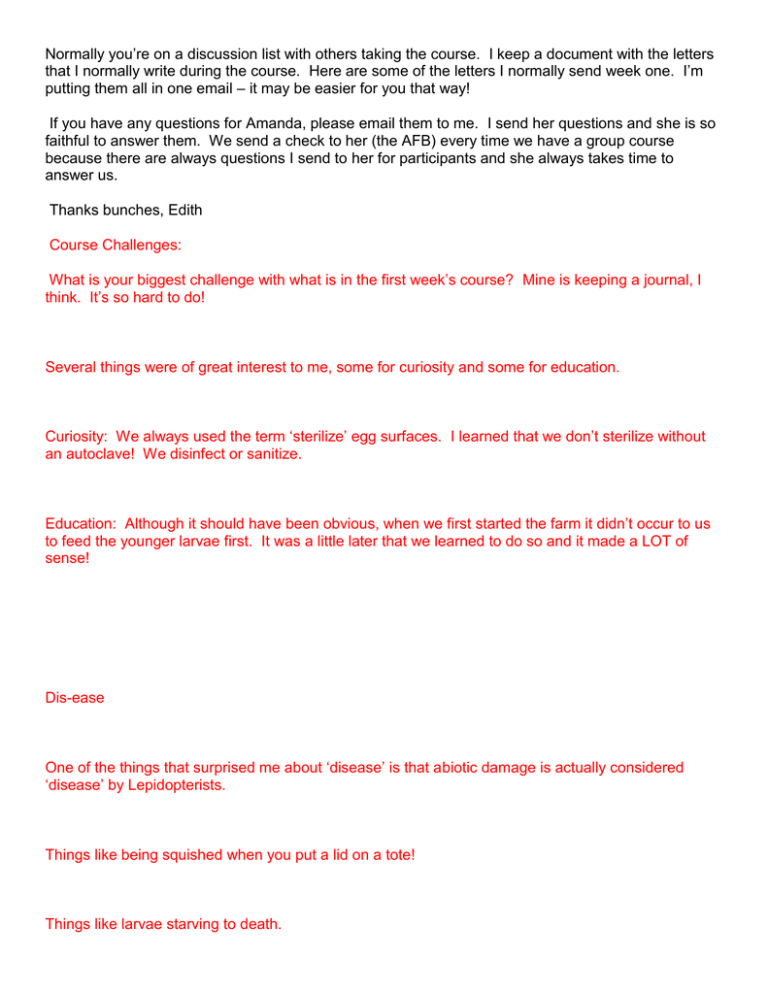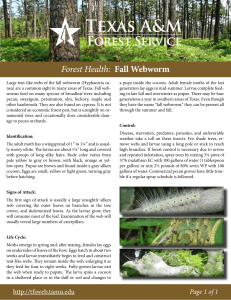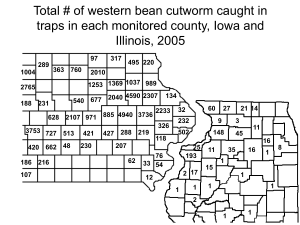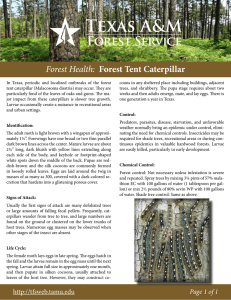Document 17729175
advertisement

Normally you’re on a discussion list with others taking the course. I keep a document with the letters that I normally write during the course. Here are some of the letters I normally send week one. I’m putting them all in one email – it may be easier for you that way! If you have any questions for Amanda, please email them to me. I send her questions and she is so faithful to answer them. We send a check to her (the AFB) every time we have a group course because there are always questions I send to her for participants and she always takes time to answer us. Thanks bunches, Edith Course Challenges: What is your biggest challenge with what is in the first week’s course? Mine is keeping a journal, I think. It’s so hard to do! Several things were of great interest to me, some for curiosity and some for education. Curiosity: We always used the term ‘sterilize’ egg surfaces. I learned that we don’t sterilize without an autoclave! We disinfect or sanitize. Education: Although it should have been obvious, when we first started the farm it didn’t occur to us to feed the younger larvae first. It was a little later that we learned to do so and it made a LOT of sense! Dis-ease One of the things that surprised me about ‘disease’ is that abiotic damage is actually considered ‘disease’ by Lepidopterists. Things like being squished when you put a lid on a tote! Things like larvae starving to death. We didn’t think many of us would connect a squished caterpillar or pupa as a ‘disease’ death, so we decided to focus primarily on what we normally think about as disease. When you speak with a pathologist, bear in mind that to them, anything that causes a dis-ease is ‘disease’. Milkweed Sap Warning Milkweed sap can cause a lot of pain and blurry vision for a few days. The first time Stephen had it he went to the ER, they rinsed his eyes, put pain meds in them, and sent him home. He stayed in bed for three days! It causes a lot of pain and light sensitivity. If it’s not real bad, he now washes out his eyes and takes ibuprofen. Ibuprofen fights inflammation and for Stephen, stops the pain unless he has a lot of sap in his eyes. Milkweed sap in eyes is very common with butterfly farmers and enthusiasts. We all (almost) learn the hard way. As if disease in Lepidoptera isn’t enough, we have milkweed sap too. Feed Youngest Larvae First! One thing that makes total sense is the idea to feed the youngest larvae first. It was something that we took a while to learn at our farm. By feeding younger larvae first, pathogens from older larvae (who had more time to ‘get sick’) won’t be transferred to younger larvae. Young larvae need fresh tender leaves. With some species, older leaves aren’t edible and they will starve to death if they’re not fed young tender leaves. Airflow is important in disease prevention. Too much air can dry out food unless it is a living plant. Cut food and artificial diet can dry out too much if there are too many holes in their rearing container UNLESS the food is put into water. Water can drown caterpillars. Funny, though, you can cover a caterpillar (that has been under water for quite a while) with table salt and it will often crawl out of the salt and do fine. Salt pulls water out of the spiracles and trachea. SOP – Disease Courser Do you have a SOP (Standard Operating Procedure) that you follow? I didn’t think that we did until I realized that if I was interrupted at the wrong time, it would throw me off. I realized that I did have a SOP even if it wasn’t written down. Although Stephen and I both have a little bit of difference in our SOP, we are close enough that the main things are the same. Things like feeding the younger caterpillars first. What is one of the main things you find important in your SOP or your normal day? Week Ones’ Material Week Ones’ material was jam packed with lots of information. As the course was being written and rewritten, edited and re-edited, one thing kept going through my mind. “That’s so obvious. Why didn’t I think of that?” Some of these things are so simple that we feel like total idiots when we sit and think about them. 1. One thing that is ‘obvious’ but didn’t occur to us at first was the fact that we needed to feed the youngest larvae first. 2. Another was the need to be very familiar with the NORMAL HEALTHY color of a larva. I was more concerned with what diseased larvae looked like. Then one day I heard someone saying about something else, “People who are trained to spot counterfeit money is trained with the real thing. They learn all about real money. The color, the scent, the faded bills, fresh bills, bills that have been washed, bills that had been bleached, real bills that had been through just about everything. They were not given counterfeit money to study. They became so familiar with real money that a counterfeit bill stood out like a sore thumb when they did see one.” It’s the same with larvae. If we know what they look like healthy, all instars, what they look like molting, what they smell like, how much they eat, etc, then we’ll spot something unusual right away. 3. If someone suggests something new, we learned not to do the whole she-bang! We now do a little test first. The expense and time and stock we lost by doing a change all at once has taught us a valuable lesson. 4. SOP; one night I didn’t sleep well. I had only about three hours sleep. As I fed larvae the next morning, I was fully aware that my slower thinking and tiredness had affected my SOP. I made many mistakes. Not big mistakes and nothing that caused problems, but they could have caused problems. 5. Not eating well, odd scents, slower movement; there are many warning signs. One day Stephen opened a tote to feed larvae and noticed a bad odor. He marked a tote “odor” and the date. Two days later, many were dead. They were acting fine but the odor was different. Now, when we detect a foul odor, we simply destroy the contents of the container. It saves time, food, and there is less chance of spreading disease. Not all containers (larvae) that have an odor are dangerous. Not paying attention is dangerous! 6. Reduced egg production; this can come on so slow that you never notice it. Then when you finally reach the point where you know something is wrong and you replace your breeding stock with new stock, suddenly 20 females are laying over twice the number of eggs than the older stock. This has happened to us several times. 7. One of our best friends is the Vis-à-vis pen. It can be wiped off easily. It is a great way to mark a rearing container or cage or sleeve with notes about the contents. Impossible to eradicate disease from your facility? It has been asked in past courses if some diseases are impossible to eradicate. We have heard that some diseases are impossible to eradicate. But we’ve not found that to be the case at our farm (so far). We’ve had just about all the bad diseases, I think, over the last 9 or 10 years. But with a good clean up we won’t have trouble for a while. Then we figure we bring it in from somewhere and it starts all over. Sigh. Perhaps we just stir up old pathogens, we can’t be absolutely sure. When it comes to running the farm, we aren’t as ‘good’ as we should be. What is taught in the course isn’t what probably any of us actually completely do; it’s what we should do! Consider this; a large facility raises a moth known for nosema. It had good breeding stock and no trace of nosema in the stock for several years. Suddenly the air conditioner went out and the temps went up 15 degrees for a few hours. Within three days, they were losing stock to nosema. (I think I have the info correct here.) Where did the pathogens come from? It was already in the stock and had been for years. (This information came directly from the University that experienced that particular problem.) Pathogens can be in stock but not active, so to speak. When stress hits, then they become sick. Otherwise, they are ‘healthy’. They are somewhat like humans; we do fine with some things in our bodies until we become emotionally or physically stressed, malnourished, or something like that. Then suddenly we get sick and sometimes it is fatal. It was already in us. Consider someone who gets caught in the rain in the winter and can’t get to a warm spot for hours. He is shivering and miserable. The next day he has a miserable head cold. It isn’t because the cold pathogens weren’t there already; his body just became too busy doing other things than fight the pathogens, so to speak. Some diseases may take months of careful selective breeding to eradicate it from your breeding stock, such as nosema. In those cases, it is more cost efficient to destroy your old stock and purchase or obtain new clean stock than to shut down your facility to work for months with infected stock. The first step in identifying diseased pupae is to know EXACTLY what healthy pupae look like. The new gal should be VERY familiar with what is normal. (We cover this in the course but it’s important so I’ll go ahead and write it now too.) The story is that when people are trained to spot counterfeit money, they are given real money to study. I looked it up on the internet and found that other people had wondered if this story was true. http://www.challies.com/archives/articles/counterfeit-det.php It’s the same with us and our insects. Once we know what is normal, we will find it easy to recognize when something is not normal. There are many signs and symptoms of disease and learning to recognize each one would be difficult. What may mean disease in one species is healthy in another. We need to learn EACH SPECIES; what is normal and healthy. When anything catches our attention and stands out, we need to pay attention. It doesn’t mean that something IS wrong, it means that it CAN BE wrong. Eggs; color off, sunken (infertile), dark all over instead of one area (trichogramma wasps), etc. Larvae; color off, smell off, activity unusual, consistency unusual, etc. Pupae; color off, not active (species that move), smell off, texture wrong, etc. ~Edith






